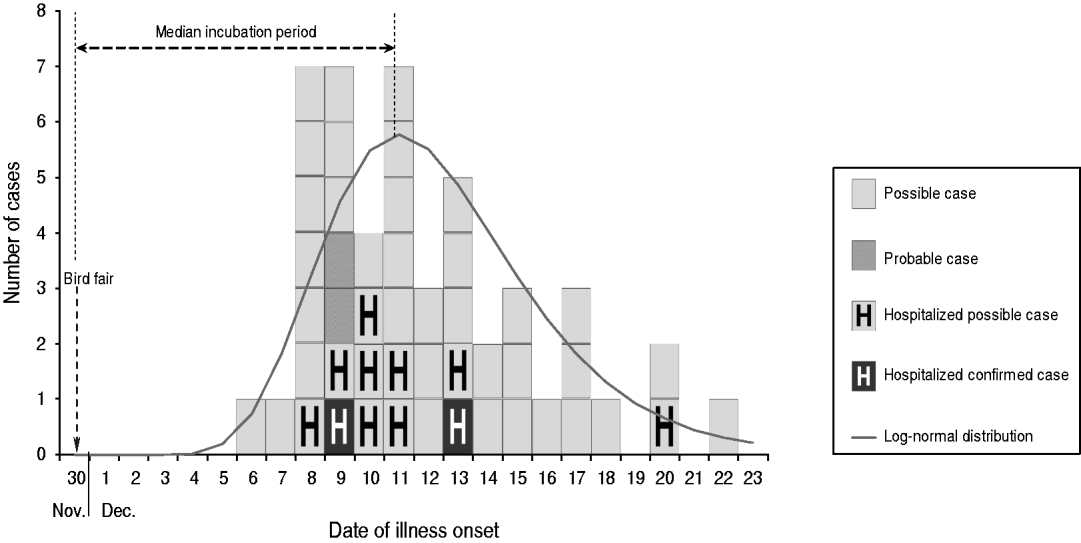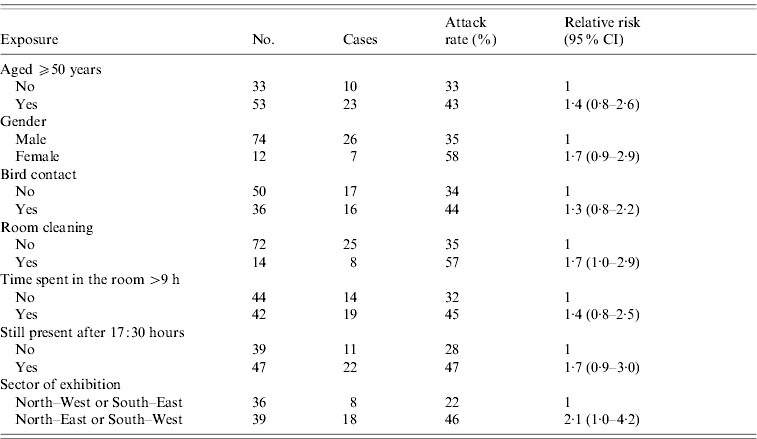Psittacosis is a bacterial zoonosis caused by Chlamydophila psittaci. The reservoir is formed by all birds. They are often asymptomatic and may excrete the bacteria intermittently. Infection usually occurs when a person inhales aerosolized particles from birds' dried faeces contaminated by the organism. Human-to-human spread has not been reported. Waste material in the birdcage may remain infectious for weeks. Psittacosis causes influenza-like symptoms, associated or not with pneumopathy with variable severity. The incubation period ranges from 5 to 30 days. Treatment with specific intracellular antibiotics such as macrolides, cyclins and quinolones is effective when administered early. Most diagnoses are established by use of microimmunofluorescence (MIF) to test for antibodies against C. psittaci in paired sera. The direct detection of this microorganism is difficult because cell culture from the patient's sputum, pleural fluid, or throat swab requires a high-protection laboratory and no commercially nucleic acid amplification test (NAAT) is available [1].
On 19 December 2008, in the context of an ongoing survey on psittacosis [2], three hospitalized cases of suspected psittacosis infection were notified by respiratory disease clinicians from a local hospital to the Regional Epidemiology Unit of Pays de la Loire, France. They had all attended a bird fair. This fair was organized by an association of amateur breeders of Psittacidae in a village showroom on 30 November. It lasted 1 day and attracted 83 exhibitors, three organizers, about 600 visitors plus 1500 birds.
The objectives of the investigation were to: (1) describe the outbreak, (2) identify risk factors during the bird fair, (3) identify a potential source of contamination in order to implement preventive measures and prevent further spread.
An active search for cases was implemented among persons attending the bird fair in November 2008 through contact with the bird fair organizers. A standardized questionnaire was sent to the exhibitors and organizers (for whom an exhaustive list was available) in order to collect information on sociodemographic data, clinical data, laboratory tests results and exposure factors related to participation in the bird fair. Active case-finding of visitors was done through contact with exhibitors, organizers and local clinicians.
A suspected case was defined as a person with fever and/or at least one respiratory symptom (cough or pneumonia) in December 2008 who had attended the bird fair in November 2008. A confirmed case was a suspected case with either a positive detection of C. psittaci by two in-house TaqMan PCR tests in a respiratory sample (throat swab), or a seroconversion, or a fourfold increase of IgG titre diagnosed by microimmunofluorescence (Chlamydia MIF Focus®, Eurobio, France). Two real-time PCR tests were used for human specimens in this study, one targeting a C. psittaci-specific incA gene [Reference Menard3], and one targeting a Chlamydiaceae-specific 23S rRNA gene [Reference Ehricht4]. A probable case was a suspected case with either a single IgM titre ⩾16 or a single IgG titre ⩾128. A possible case was a suspected case with an epidemiological link to a confirmed case.
A retrospective cohort study was conducted only among exhibitors and organizers to evaluate risk factors for developing psittacosis infection. For analysis purposes, the showroom was divided into four sectors along north–south and east–west lines. The sectors in which attack rates were the lowest served as a reference in the analysis. Relative risks (RR) with 95% confidence intervals (CI) were calculated using Stata v. 9.0 software (StataCorp., USA).
The fit of the epidemic curve to a log-normal distribution was tested by Kolmogorov–Smirnov test in order to reinforce the hypothesis of an exposure to a common source.
An environmental investigation including a veterinary survey of birds belonging to volunteer exhibitor cases was conducted by veterinarians of the French Food Safety Agency (AFSSA) and the local veterinary services. Samples (birds' cloacal swabs and droppings) were analysed with a Chlamydiaceae-specific real-time PCR targeting the 23S rRNA gene [Reference Ehricht4] by AFSSA's laboratory.
Forty-eight suspected cases were identified in participants: two confirmed cases (positive PCR), two probable cases (IgG titre ⩾128) and 44 possible cases. Sixty percent of the cases (29/48) had a serological test. Of 11 hospitalized cases, three had PCR performed. Genotyping of the human C. psittaci-positive samples was not possible due to their low DNA content. Dates of onset of symptoms of the 48 cases ranged from 6 to 22 December 2008. Sixty-nine percent of cases occurred from 8 to 13 December 2008. The median incubation period was 11 days (range 6–22 days). The epidemic curve fitted the log-normal distribution (P=0·53) (Fig. 1).

Fig. 1. Distribution of psittacosis cases, by day of onset of symptoms, attending the bird fair, Western France, December 2008.
Fever was the most frequently reported symptom (96%, 46/48). Pneumonia and cough were reported in 63% (30/48) of cases. No deaths were reported. Of the 48 patients, 98% (47/48) consulted a general practitioner and 23% (11/48) were hospitalized. The median duration of hospitalization was 6 days (range 1–10 days).
For the risk-factor analysis, all 83 exhibitors and three organizers completed the questionnaire (74 men, 12 women). The overall attack rate was 38% (33/86). Of the 33 cases, two were confirmed, two probable and 29 possible. The attack rate did not differ by age or gender. The location of exhibition of the birds in the showroom during the fair was known for 75/83 exhibitors, 26 of whom became ill (Fig. 2). The attack rates in exhibitors placed in the North–East, North–West, South–East and South–West sectors were respectively 48% (10/21), 20% (3/15), 24% (5/21) and 44% (8/18).

Fig. 2. Map of the showroom and distribution of psittacosis cases (n=26) during the bird fair, Western France, December 2008.
For analysis purpose, the sectors South–East and North–West in which attack rates were the lowest, were grouped together. Attack rates for exhibitors were compared to those in the grouped sectors North–East and South–West. Of the exhibitors whose location was known, the risk of being ill was doubled for those placed in the North–East or South–West sectors than those placed in the reference sector (RR 2·1, 95% CI 1·03–4·18) (Table 1).
Table 1. Attack rates of psittacosis infection and relative risk with 95% confidence intervals (CI) of characteristics of the 86 exhibitors and organizers present at the bird fair, Western France, December 2008

Six exhibitors agreed to their birds being sampled. Overall 64 birds were tested and all were negative. Pooled faecal samples of birds belonging to a possible case exhibitor tested positive for Chlamydiaceae by real-time PCR. These birds, belonging to a possible case, were exhibited in the North–East sector of the showroom (Fig. 2).
During the fair, the windows of the showroom were locked and there was no mechanical ventilation. The maximum number of people allowed in the showroom at a given time was 300 persons.
In this outbreak, the attack rate in exhibitors and organizers (38%) was very high. Such a high rate has been reported in an outbreak in a veterinary hospital [Reference Heddema5] and in another local cluster after a bird show [Reference Koene6] in The Netherlands. Psittacosis outbreaks in professionals have been reported in veterinary surgeons [Reference Palmer, Andrews and Major7] and in poultry slaughterhouses [Reference Laroucau8]. Some other clustered cases have been described, e.g. a rural town in Australia in 1998 linked to indirect contact with wild birds [Reference Williams9] and more recently a bird park in Japan in 2008 [Reference Matsui10].
Two thirds of cases occurred with an incubation period between 8 and 13 days. The median incubation period of 11 days, identified by this investigation, is similar to another psittacosis outbreak in a different context [Reference Palmer, Andrews and Major7]. This period could be used in future investigations of psittacosis outbreaks when a common exposure is known. The epidemic curve fitted a log-normal distribution, which reinforced the hypothesis of an exposure to a common source.
Despite a veterinary examination at the beginning of the fair, no illness was reported in exposed birds. Asymptomatic birds shedding the bacteria intermittently are a frequent phenomenon. Stress induced by change of environment could cause excretion of Chlamydophila by birds and be responsible for human infection [Reference Vanrompay11]. Overall conditions of inadequate room ventilation, especially in the context of specific pollution linked to the presence of large numbers of birds were able to cause an increase in bacterial load in the environment.
Laboratory confirmation of psittacosis is difficult. Search by PCR was only performed for hospitalized cases. The necessity of two serum specimens with a 5-week interval is needed to show a seroconversion or a significant rise of IgG titre, but the second serology is rarely performed. Moreover, serology results should be interpreted with caution due to cross-reactions with other Chlamydophila spp. more common in the general population (e.g. C. pneumoniae). Confusion with seasonal influenza seemed unlikely: the seasonal influenza epidemic started after the psittacosis epidemic. Moreover, asymptomatic infections in people exposed to infected birds have been described previously [Reference Moroney12] and the number of psittacosis cases may have been underestimated.
To prevent such an outbreak during a bird fair our recommendations include: informing exhibitors and organizers about the risk for psittacosis, avoiding stressing the birds during the fair, providing enough ventilation of the room and using protection during disinfection measures [Reference Smith13, Reference Belchior14].
ACKNOWLEDGEMENTS
The authors thank Dr Sylvie Dugas, Dr Robert Vegas, Gaëlle Duclos, and Gérard Tessier from the local health services of Mayenne for their participation in the epidemiological investigation; Françoise Obeniche and Maïthé Clerc from the National reference centre of Chlamydia for technical support on laboratory tests; and Brigitte Helynck, Biagio Pedalino, Marie-Anne Botrel and Véronique Vaillant from InVS for reading and commenting on the manuscript.
DECLARATION OF INTEREST
None.





